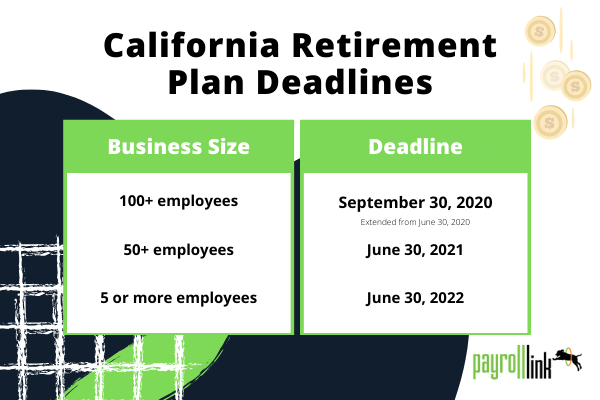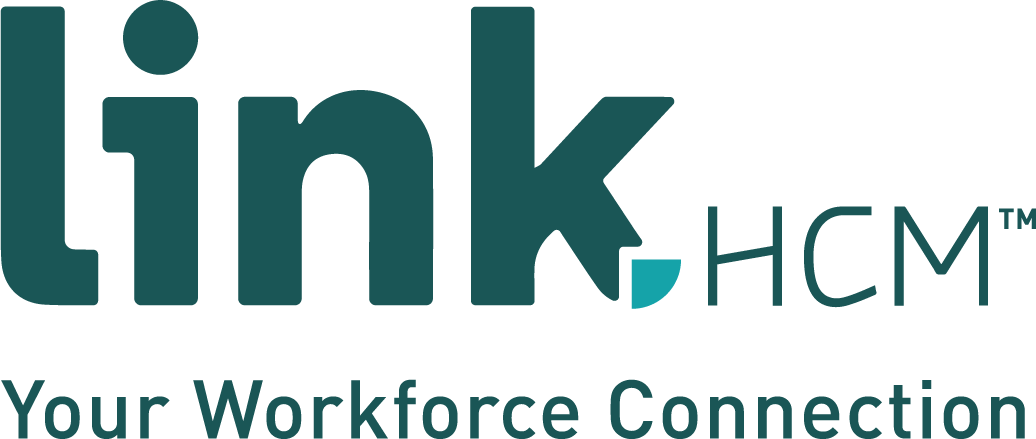 As many California business owners know, changes to retirement plan requirements have been on the docket for many years, and have come to fruition in recent years. In 2016, California passed state legislation to begin mandating businesses to provide their employees with retirement plan options.
As many California business owners know, changes to retirement plan requirements have been on the docket for many years, and have come to fruition in recent years. In 2016, California passed state legislation to begin mandating businesses to provide their employees with retirement plan options.
Now, in 2020, these requirements will begin going into effect for businesses statewide, with rolling deadlines based on a company’s number of employees.
As a California business owner, are you prepared for how these changes will impact your business? Do you currently offer your employees a 401(k) plan? If not, do you know what options are available and the best fit for your employees?(and you)
Let’s dive into the 401(k) requirements in the state of California, from the current situation to a breakdown of the legislation, and everything you’ll need to know as a business owner to remain compliant (and competitive) in the state.
- Why is California Mandating Retirement Plans?
- A Look at State-Mandated Programs
- What do the California State Requirements Look Like?
- Comparing Retirement Savings Plan Options
- 5 Myths Why Businesses Don’t Start a 401(k) MEP Plan
And, if you want to know more, register for our webinar on February 6, where you can ask live questions and get more background information on the California 401(k) requirements and CalSavers.
Why is California Mandating Retirement Plans?
California’s Retirement Plan Crisis
The United States is experiencing a drastic saving crisis; looking at the nation as a whole, nearly ⅓ of Americans, or 55 million, have NO retirement savings, while 22% of Americans have less than $5,000 total saved for retirement.
In California, the situation is not much better. Half of California private sector workers have no retirement assets, and about 7.4 million California private sector employees age 25-64 (61% of this segment) do not have access to an employer-sponsored retirement plan.
According to experts, we need to prepare to have 70-80% of our current wages annually saved up per year for our retirement years. And, counting all household assets, most working-age California families are under-prepared for retirement.
This concerning situation is due to a gap in coverage for small businesses with retirement plan options that make sense for them. And yet, studies show that employees are more likely to save when given access to a retirement plan at work, and are more likely to accept a job when a company provides retirement benefits.
A Look at State-Mandated Programs
With these staggering national statistics on the current retirement plan situation, states are taking it upon themselves to ensure employees have access to savings programs. State-run plans are providing private workers with access to retirement plans via their employers.
These plans are sponsored by the state, facilitated by employers, and funded by employee investments via payroll deductions. While the plan has a default contribution of 5% of gross pay, this contribution level can be adjusted by the employee.
Nationally, these plans have the potential to provide retirement plan access for as many as 55 million U.S. workers who previously did not have access to an employer-provided plan. The potential impact is huge, and you can expect to see legislation enacted in additional states in the coming years.
Other State-Mandated Retirement Programs
In response to the national savings crisis, 30 states have considered legislation for state-mandated retirement programs. And, as of January 2020, 10 states have enacted legislation to put these plans into action.
States that have a state-sponsored retirement plan:
- California
- Connecticut
- Illinois
- Maryland
- Massachusetts
- New Jersey
- New York
- Oregon
- Vermont
- Washington
As of November 2019, three states have officially implemented a mandated retirement savings programs for employers: California, Oregon and Illinois.
What do the California State Requirements Look Like?
Background on California Legislation
In 2016, Governor Brown signed legislation requiring the State of California to begin development of a workplace retirement savings program for private sector workers who are not offered a retirement plan by their company. The California State program, CalSavers, would ensure that an estimated 7.5 million California workers would soon have access to workplace retirement savings.
In November 2018, a pilot program of CalSavers was launched with a small group of participating employers, and, effective July 2019, all employers in the state of California are now able to sign up on their own accord.
What are the requirements for employers?
The new legislation mandates that any employer in the State of California with 5 or more employees will have to offer an employee-sponsored retirement plan (also known as a 401(k) Plan) to their staff. Your plan can take shape in a number of ways, but to be compliant with the state’s requirements, it simply must give employees the ability to defer money from their paycheck into their retirement plan. Deadlines are staggered based on a company’s number of employees.
What are options for employers?
By each deadline, businesses must certify that they have a retirement plan in place, or they have two options to comply with the state mandate:
- Start a retirement plan on their own
- Register with the state program and start an IRA plan (also known as CalSavers)
Would a profit-sharing plan meet the guidelines of this legislation?
No, on its own, a profit-sharing plan would not meet the requirements, as it does not give employees the ability to defer money from their paychecks.
Deadlines
What is the 401(k) deadline in California? California is using a three-year tiered rollout schedule with staggered deadlines. Registration deadlines have been established based on the number of employees a business has, and the first state deadline for compliance is September 30, 2020 for companies with 100+ employees.

How long does it take to start making contributions to a new plan?
Contributions can start within 60 days. So, if you’re looking to be up and running by September 30, 2020, you should decide which option is best for your business no later than July 30, 2020.
But don’t wait until the last minute to start setting up your 401(k) plan. Get Started Today
What counts as an Employer-Sponsored Retirement Plan?
An employer-sponsored retirement plan could look like a number of things:
- 401(k) Plan
- Qualified Annuity Plan
- Tax-sheltered Annuity Plan
- Simplified Employee Pension
- Simple IRA Plan
- Governmental deferred compensation plan
- Note - does NOT include payroll deduction IRAs
If an employer does not select an external source, the default plan is CalSavers -- a Roth IRA with automated enrollment, and a default savings rate starting at 5% of gross pay (but employees can specify a different rate at any time). In the future, CalSavers will offer a traditional IRA as well.
What happens if a business does not register by the deadlines?
If a business does not register by the deadline, they will receive noncompliance penalties based on their employee count.
Proposed penalty fines range from $250 per eligible employee if an employer remains noncompliant after 90 days of being served notice, and increases to $500 per eligible employee if noncompliance reaches 180 days. For businesses with more than 100 employees, missing these deadlines could result in hefty fines for employers.
What designates an eligible employee?
Right now, the legislation isn’t specifying eligibility within your employee count (i.e. part-time transient employees vs. full-time salaried employees), it is strictly focusing on the number of people you employ.
When it comes to part-time employees, you can set up exclusions so that they aren’t included in your retirement plan offering. However, once a part-time employee exceeds 1,000 hours in a year, they are considered a full-time employee and must be included in the program.
What is the Secure Act?
California’s recently-passed Secure Act has further changed how the state designates part-time employees. The new law signed into effect in December 2019 designates that if an employee works at least 500 hours for three consecutive years, now they are eligible to participate in the plan. No matter how many, or how few, hours they work in future years, they will continue to be eligible for your plan.
Comparing Retirement Savings Plan Options
Now that you understand the legal background and what is required of employers beginning in 2020, let’s take a deeper look at the different retirement savings plan options available to employers.
>> Download Here: [CHECKLIST] California Retirement Plans Compared
CalSavers Retirement Savings Plan
CalSavers is a state-run automatic enrollment program that allows employees to contribute up to $6,000 per year to a Roth IRA. Employees 50 years of age and older are allowed to contribute up to $7,000 annually.
While CalSavers has the potential to provide positive impact for employees statewide, in some ways, it’s a less-than-ideal option for California employers.
Here are some considerations and pitfalls of CalSavers for employers:
- Employees will be auto-enrolled after 30 days.
- The default contribution amount is 5% and there is an automatic escalation provision, meaning the rate will increase by 1% each year, but will be capped at 8%.
- Note that an employee can adjust and decrease their contribution rate after it is set up, but they must do so on the CalSavers website directly (can’t be integrated with your workforce management tool).
- CalSavers account holders (employees) will have to pay management and record-keeping fees of between 0.85% - 0.92% of their account balances annually. For employers with large employee accounts, this can quickly become a substantial cost.
- Contributions are limited to $7,000 annually, limiting employees who want to save more.
- The program is overseen by a state board, and funds are managed by Boston firm State Street Global Advisors.
- There is a limited investment menu available to employees. They can choose from a money-market fund, a bond fund, two stock funds and target-date funds.
- As an employer using CalSavers, you physically have to import each new employee’s data to the CalSavers website when you hire them, and must physically take money out of their paycheck then submit it over to CalSavers’ ACH. This is a hugely time-consuming administrative burden for the employer.
Read More: What is the CalSavers?
Starting Your Own Plan
If you’d like, you can work with a provider to develop your own “startup plan” that is created individually for your company.
Startup plans can be a great option for large organizations with complex retirement plan structures. For instance, say you have 3,000 employees and would like to offer two drastically different 401(k) plans, one level for executives and one for the rest of your employees. To achieve this, it would be worth the investment for you to work with an outsourced advisor to create a Startup Plan that is unique to your company.
For the majority of employers who are looking for some plan flexibility, but not to incur high fees for 401(k) plan management and administration, startup plans do not make the most sense.
Here are some considerations and pitfalls of startup plans for employers:
- High fees incurred by employers.
- Private plans require an annual audit, and this can cost up to $12,500 if you have 100+ employees.
- Ongoing administrative burden, including processing contributions, as well as the tedious process of downloading and uploading remittance files every payroll.
- Additional liability, with your organization responsible for signing an annual 5500 and audit report, as well as undergoing annual compliance testing and employee notification process.
- Hiring a third-party administrator and broker.
- Quarterly documented committee meetings regarding the plan.
- Limited investment choices with high expense ratios.
The Payroll Link 401(k) MEP Plan
Powered by The Standard & Reilly Financial Advisors
For Payroll Link partners, there is another solution available in response to the California state mandates. The Payroll Link 401(k) MEP Plan, Powered by The Standard & Reilly Financial Advisors, is a plan that provides the best for both the employee and the employer.
Administration is automated, with plan integration automatically into the Payroll Link Human Capital Management solution. This means that your employees don’t have to manage the tedious administrative tasks of reporting deductions each payroll cycle, or processing contributions. Everything happens automatically, and in the same place as the rest of your HR, Payroll, and Time & Attendance tools.
Benefits of The Payroll Link 401(k) MEP Plan for Employers
- No ongoing cost to you, the employer
- Connect to your other HCM tools for efficiency
- Eliminate administrative headaches
- Increase efficiency and reduce mistakes
- Enjoy fast and easy onboarding
Benefits of The Payroll Link 401(k) MEP Plan for Employees
- Low cost to participants
- Access to big business benefits
- Flexibility in plan design
- Access to personalized financial advising
What is a Multiple Employer Plan (MEP)?
A Multiple Employer Plan (MEP) is a retirement savings plan adopted by 2+ unrelated employers. It benefits employers through economies of scale, combining the buying power of businesses with smaller employee counts to give them access to program rates which are usually only available to massive companies.
Payroll Link is the MEP sponsor, meaning we take responsibility for all administrative duties and liability for the plan. Annually, we invest in a costly audit for the plan, taking that financial responsibility off of your plate entirely.
>> Read More: What is an MEP Retirement Plan and Why Does it Benefit Me?
Could I offer multiple plans, the CalSavers plan in addition to another plan?
It would not be recommended to offer different multiple plans within one business, as given the nature of the CalSavers plan, offering both would cause a lot of trouble and confusion down the road.
5 Myths Why Businesses Don’t Start a 401(k) Plan
Nationally, many businesses are hesitant to begin offering a 401(k) plan for a number of reasons, many being too busy to think about looking into retirement options themselves. But for those who do consider 401(k) plans, some common misconceptions could deter them.
Let’s look at the 5 top myths why businesses don’t start a 401(k) Plan.
My business is too small for a 401(k) plan.
A common misconception among small businesses is that 401(k) plans only make sense for large businesses. This is false; in reality, the smaller the company, the greater the tax benefit could be for the owners to offer a 401(k).
If you have a small company, know that by not offering a 401(k) plan, you could be missing out on a great way to shield a large amount of money on your annual taxes.
It’s too expensive.
It can be undoubtedly expensive to create your own individualized startup plan from scratch. But, one option is making great plans much more accessible and affordable: the Payroll Link MEP 401(k) Plan. With this option, you get the economies of scale of a $100 million plan overnight, with no annual audit cost or liability burden on your company.
Employees aren’t interested.
While many corporations don’t expect a high number of their employees to participate in deferring part of their paychecks, statistically, this does not prove to be the case. In fact, whether or not an employer offers retirement benefits has proven to be a huge factor when candidates are considering whether or not to accept a position.
Additionally, the IRS incentives the lower-income employee base with annual tax credits. Employees who make $64,000 income or less and make a certain level of contribution to their 401(k) plan during the year are eligible for a tax credit, available if they fill out Form 8880.
Matching is required.
While many business owners think otherwise, employer matching is not a state-mandated requirement. Each 401(k) plan is going to be set up in one of the following ways, which is the choice of the employer:
- Safe Harbor Plan - You as a corporation have agreed to provide a match to your employees, and you as an employee will pay that out at the end of the year, no matter what.
- Non-Safe Harbor Plan - You as a corporation do not agree to match your employees’ contributions.
- But, each Non-Safe Harbor Plan has a Discretionary Match Feature where the company has the option if they choose to, at any time, to do a match or not do a match.
It’s too complicated and risky.
When starting up a new plan, there is a lot of risk and complication. However, this can be eliminated if you join a quality team, like what’s available to you through the Payroll Link MEP 401(k) Plan.
With the Payroll Link MEP 401(k) Plan, employers don’t have to worry about any of the above myths. You can provide the best for their employees without high fees, additional administrative work, or taking on more liability.
Benefits of a 401(k) Plan
There are numerous benefits to offering a 401(k) plan for your employees.
401(k) Plan Features
- Automated contributions that are integrated with your payroll and HR software
- Pre-tax contributions
- Tax-deferred growth
- Higher limits on contributions
- Reduces taxable income for employee
Flexibility in using a 401(k) Plan
- Contribute more than an IRA
- Change contribution level anytime
- Choice of pre-tax or post-tax (Roth) contribution
- Different vesting schedules
- Rollovers, loans and managed account options all available
- Profit-sharing is allowed
Ready to learn more about the Payroll Link MEP 401(k) Plan as an alternative to CalSavers?
Are you a current client of Payroll Link?




Leave a Comment